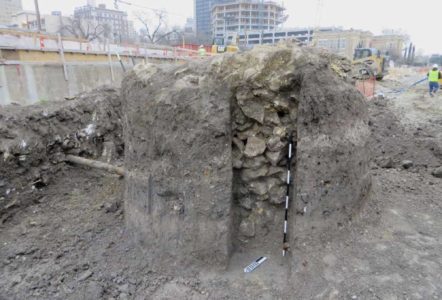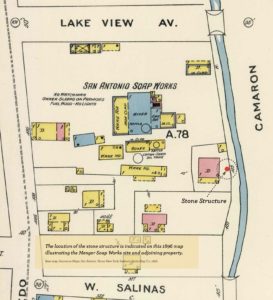Historical Features Along San Pedro Creek
Audio Tour
Audio Guía
Image Gallery
English
Español
-
A puzzling structure is discovered during excavation of the creek channel.
Before the San Pedro Creek Improvements Project began, the San Antonio River Authority commissioned a cultural resources survey to identify archaeological and historical sites that might be impacted by construction. The study revealed many significant features along the creek, including a circular stone structure located near the Menger Soap Works.
As the project proceeded in 2017, further investigations revealed that the feature was built of rough, dry-stacked pieces of limestone. The fact that the stone was laid without mortar and therefore unable to hold water eliminated the possibility of its use as a cistern. Artifacts found around the feature, including bottles, pottery, and metal fragments, dated to the late 1800s and early 1900s, indicating it was newer than the soap works that opened here about 1860. Because of its location within the new creek channel, a plan was devised to preserve the fragile structure by encasing it with mortared stonework and exposing only the top portion above water. This puzzling structure remains an interesting feature for visitors to study and develop their own theories about its historical use.
Audio Tour
When the San Antonio River Authority commissioned a cultural resources survey to identify archaeological and historical sites that might be impacted by construction, the study revealed a peculiar stone structure. The cylindrical structure was built from rough, dry-stacked pieces of limestone without any mortar, which means it could not have been used as a cistern, or a tank for storing water. When the team continued investigating, they found ceramic, glass, and metal artifacts that dated to the late 1800s and early 1900s, which is later than the year the nearby Menger Soap Works was constructed in 1860. To further add to the mystery, the excavation team also found a pipe running from the bottom of the stone structure to the creek. To safeguard this historic enigma, a plan was devised to preserve the fragile structure by encasing it with mortared stone and exposing only the top portion above water, which you can see in front of you now. Take a look at the structure poking out from the water and the excavation pictures on the sign…what do you think it was used for?To protect and preserve the stone structure in its original location,
a plan was devised to surround it with a casing of mortared limestone. The structure is seen here before the creek channel was filled with water. Today only the top portion is exposed above the water line. -
Una extraña estructura es descubierta durante las excavaciones del canal del arroyo.
Antes de que comenzara el Proyecto de Mejoras al Arroyo San Pedro, la Autoridad Fluvial del Río San Antonio encargó una investigación de recursos culturales para identificar los sitios arqueológicos e históricos que podrían verse afectados por la construcción. El estudio reveló muchas particularidades significativas a lo largo del arroyo, que incluyen una estructura circular de piedra situada cerca de la fábrica de jabón Menger.
A medida que el proyecto avanzó en 2017, investigaciones posteriores revelaron que la estructura fue construida con trozos apilados de piedra caliza áspera y seca. El hecho de que la estructura fue construida sin mortero, indica que era incapaz de retener agua, y esto elimina la posibilidad de su uso como cisterna. Los artefactos que se encuentran alrededor de esta estructura incluyen botellas, artículos de cerámica y fragmentos de metal, fechados a finales de 1800 y principios de 1900, indicando que la estructura es más reciente que la fábrica de jabón que abrió aquí alrededor de 1860. En vista de su ubicación dentro del nuevo canal del Arroyo San Pedro, se ideó un plan para preservar la frágil estructura, y se construyó un revestimiento con piedra y mortero, dejando la parte superior por encima del agua. Esta misteriosa estructura sigue siendo un tema interesante para que los visitantes estudien y elaboren sus propias teorías acerca de su uso histórico.
Audio Guía
Cuando la Autoridad Fluvial del Río San Antonio encargó una investigación sobre los recursos culturales para identificar sitios arqueológicos e históricos que pudieran verse impactados por la construcción, el estudio reveló una estructura de piedra muy peculiar. La estructura cilíndrica fue construida a partir de pedazos de piedra caliza áspera, apilados en seco sin usar ningún mortero, lo que significa que no podría haber sido utilizado como cisterna, o un tanque para almacenar el agua. Cuando el equipo continuó investigando, encontraron artefactos de cerámica, vidrio y metal que se originan a finales del siglo XIX y comienzos del siglo XX, que es más reciente que el año en que se construyó la fábrica de jabón Menger en 1860. Para añadir más al misterio, el equipo de excavación también encontró una tubería que corría desde el fondo de la estructura de piedra hasta el arroyo. Para salvaguardar este enigma histórico, se ideó un plan para preservar la frágil estructura, poniendo un revestimiento de piedra y mortero, y dejando sólo la parte superior por arriba del nivel del agua, que usted puede ver ahora mismo. Observe la estructura que sale del agua y las fotos de la excavación… ¿para qué cree que se usó?La estructura cilíndrica de piedra, no identificada, se muestra aquí después de las excavaciones arqueológicas realizadas durante el Proyecto de Mejoras al Arroyo San Pedro. La tubería que se extiende hacia el arroyo desde la parte inferior de la estructura hace que el misterio sea más complejo.
Para proteger y preservar la estructura de piedra en su ubicación original, se ideó un plan para rodearla con una cubierta de piedra caliza y mortero. Aquí se muestra la estructura antes que el arroyo se llenara con agua. Actualmente solo se puede apreciar la parte superior, que está fuera del agua.




